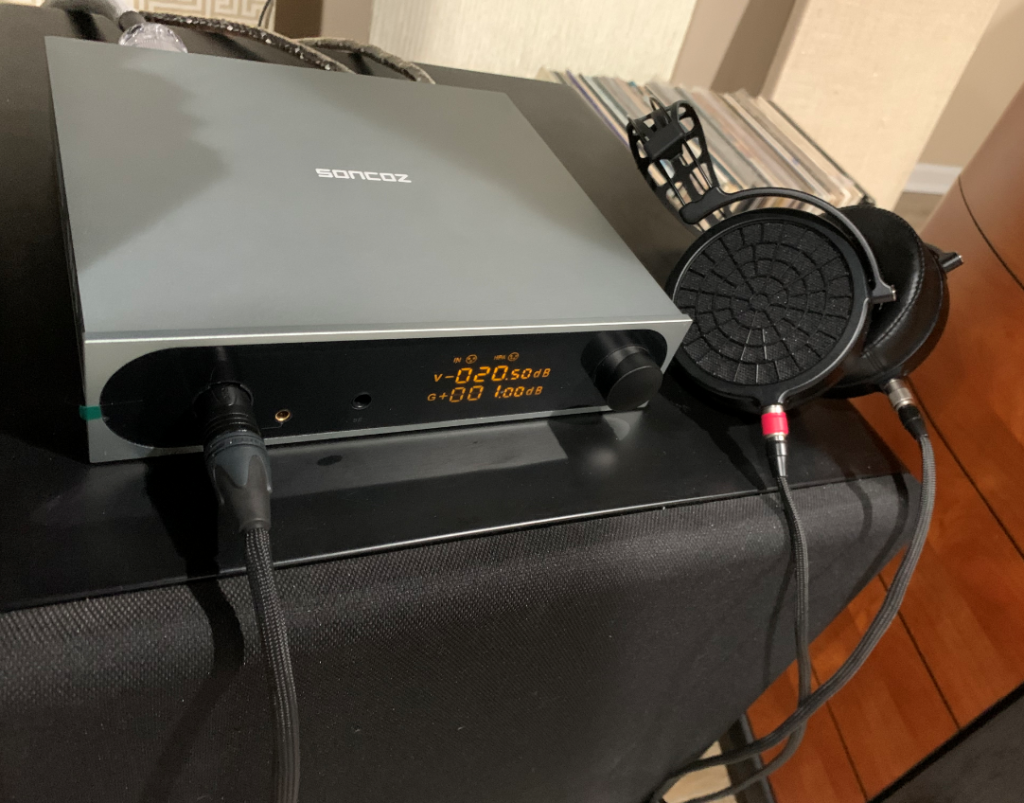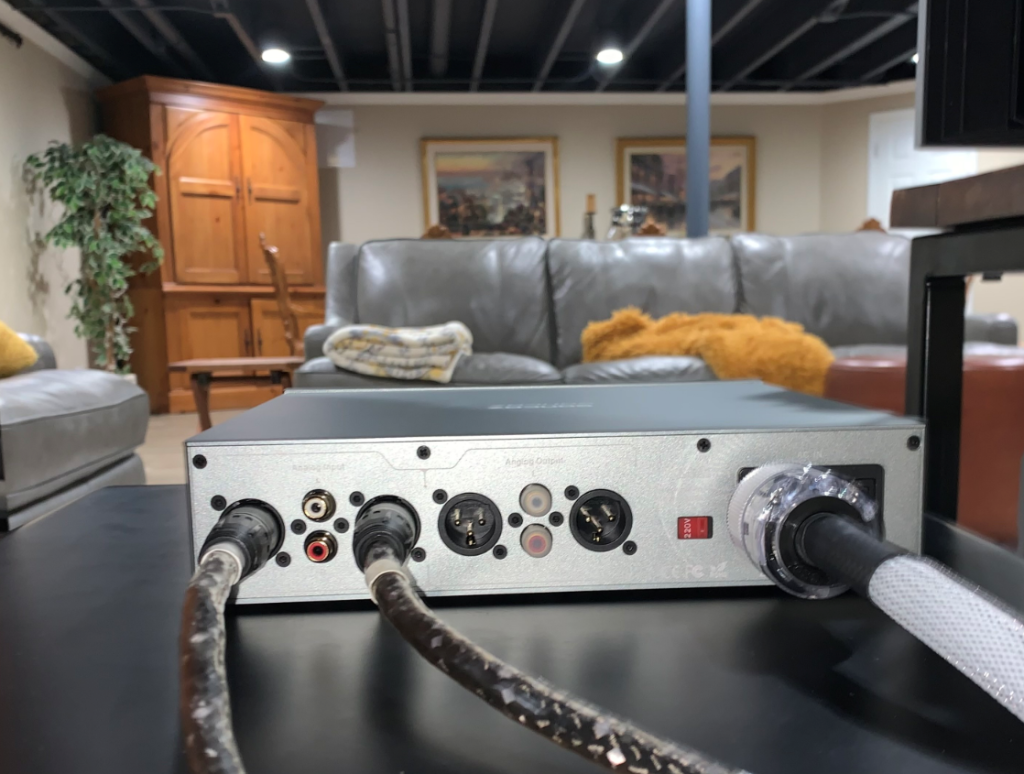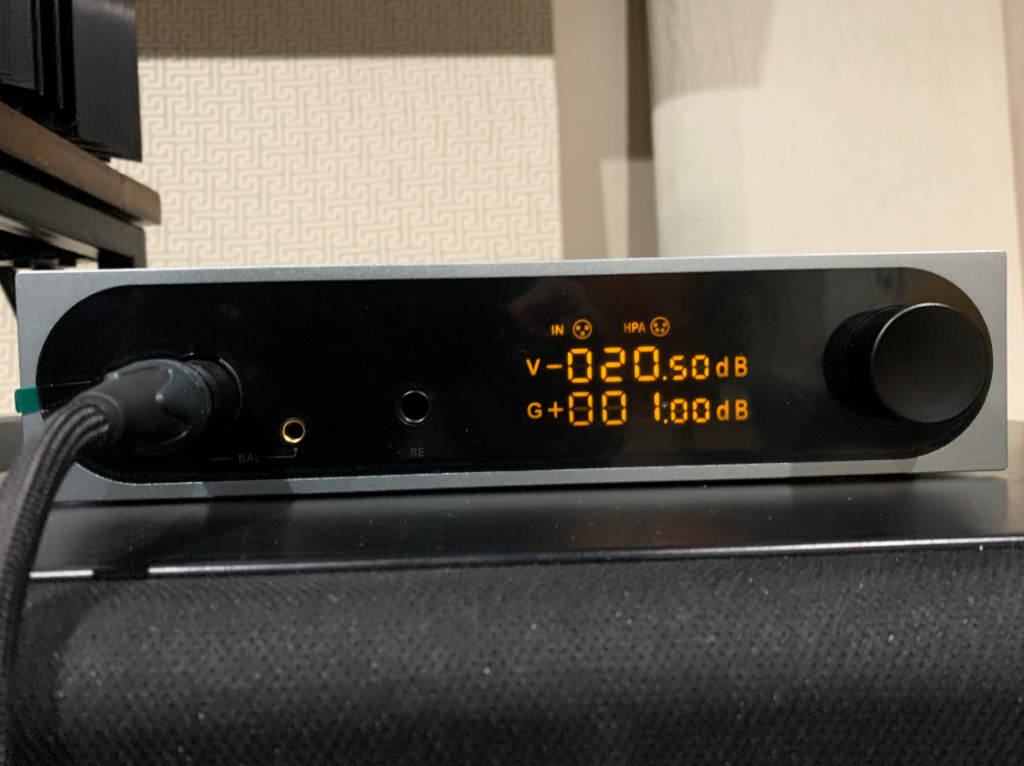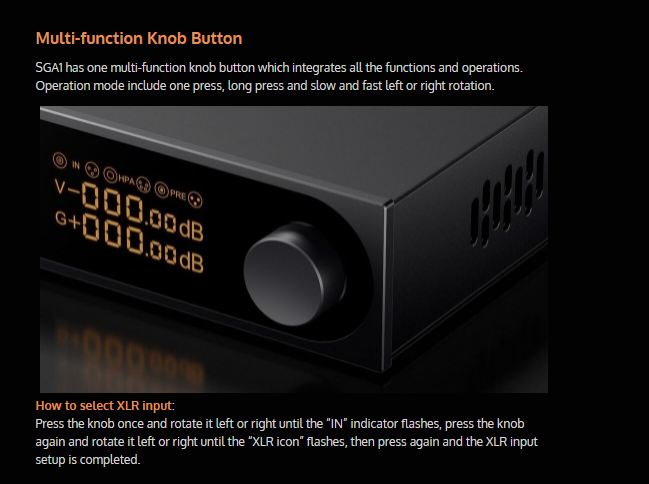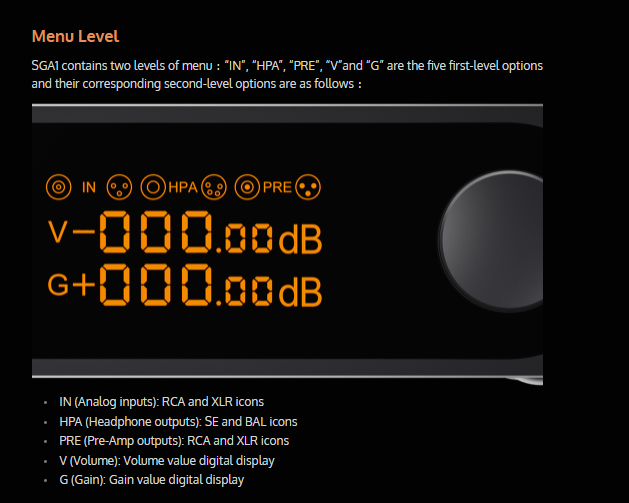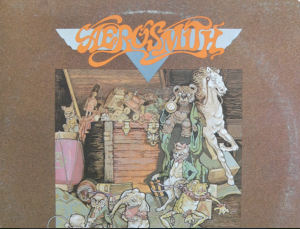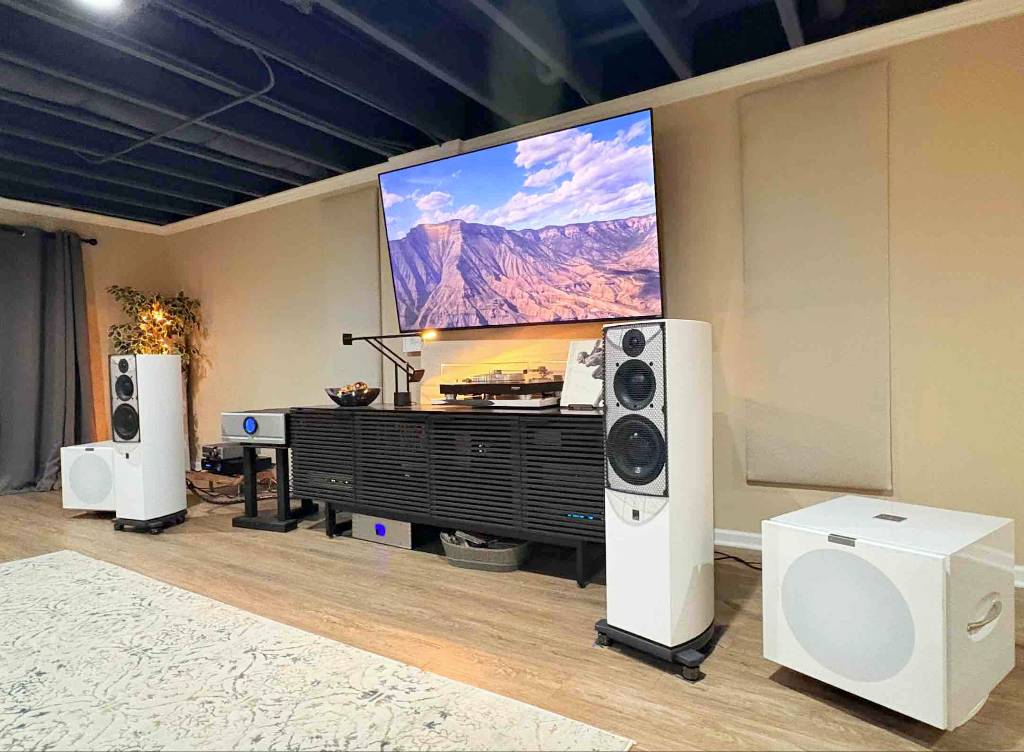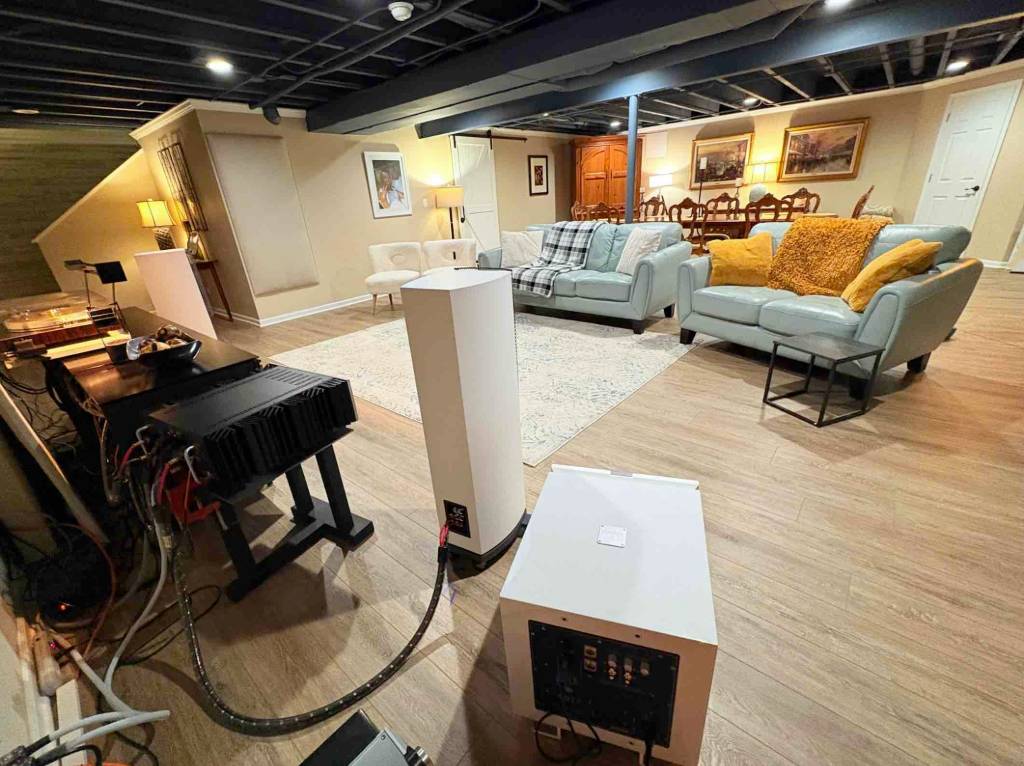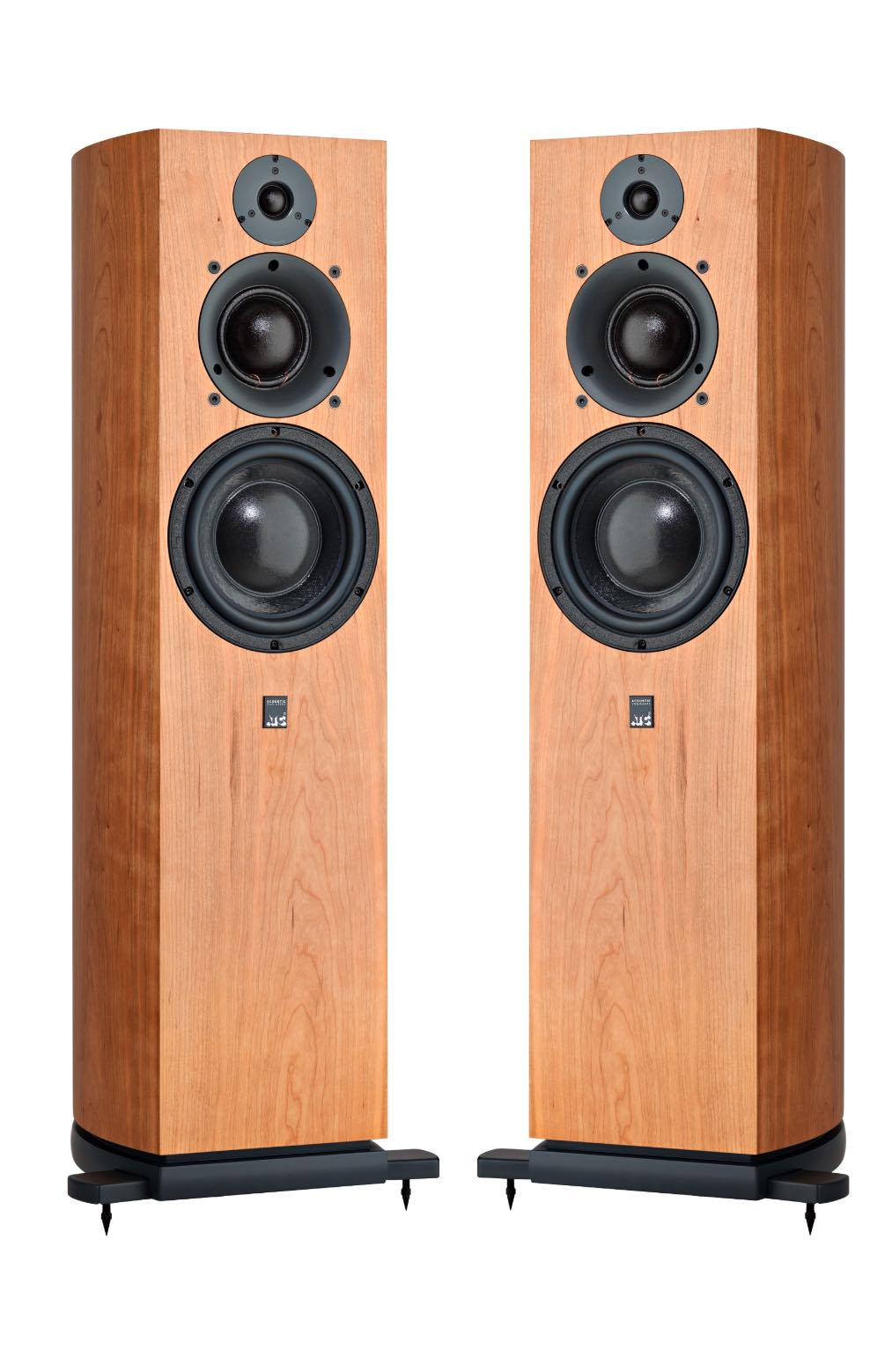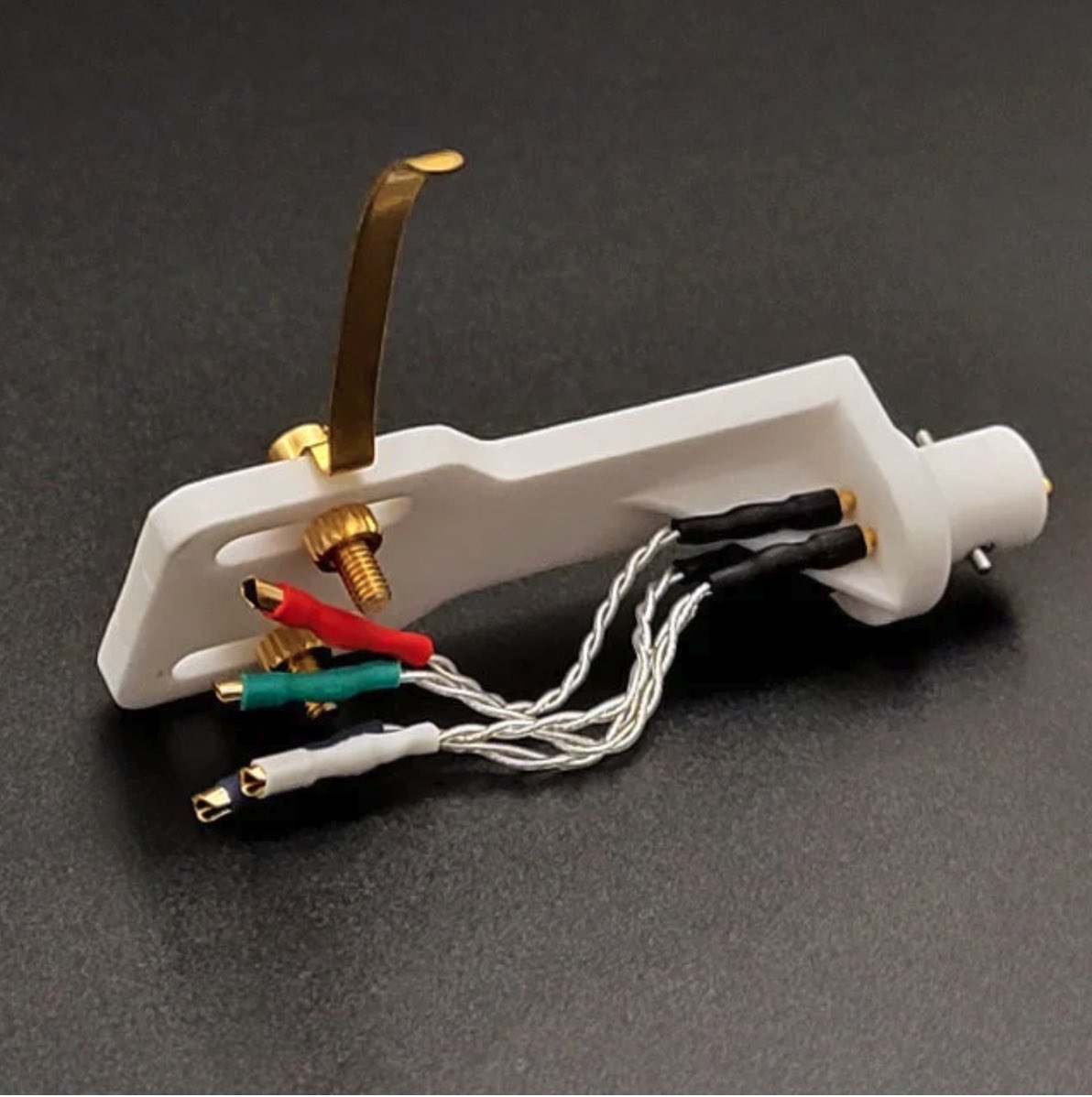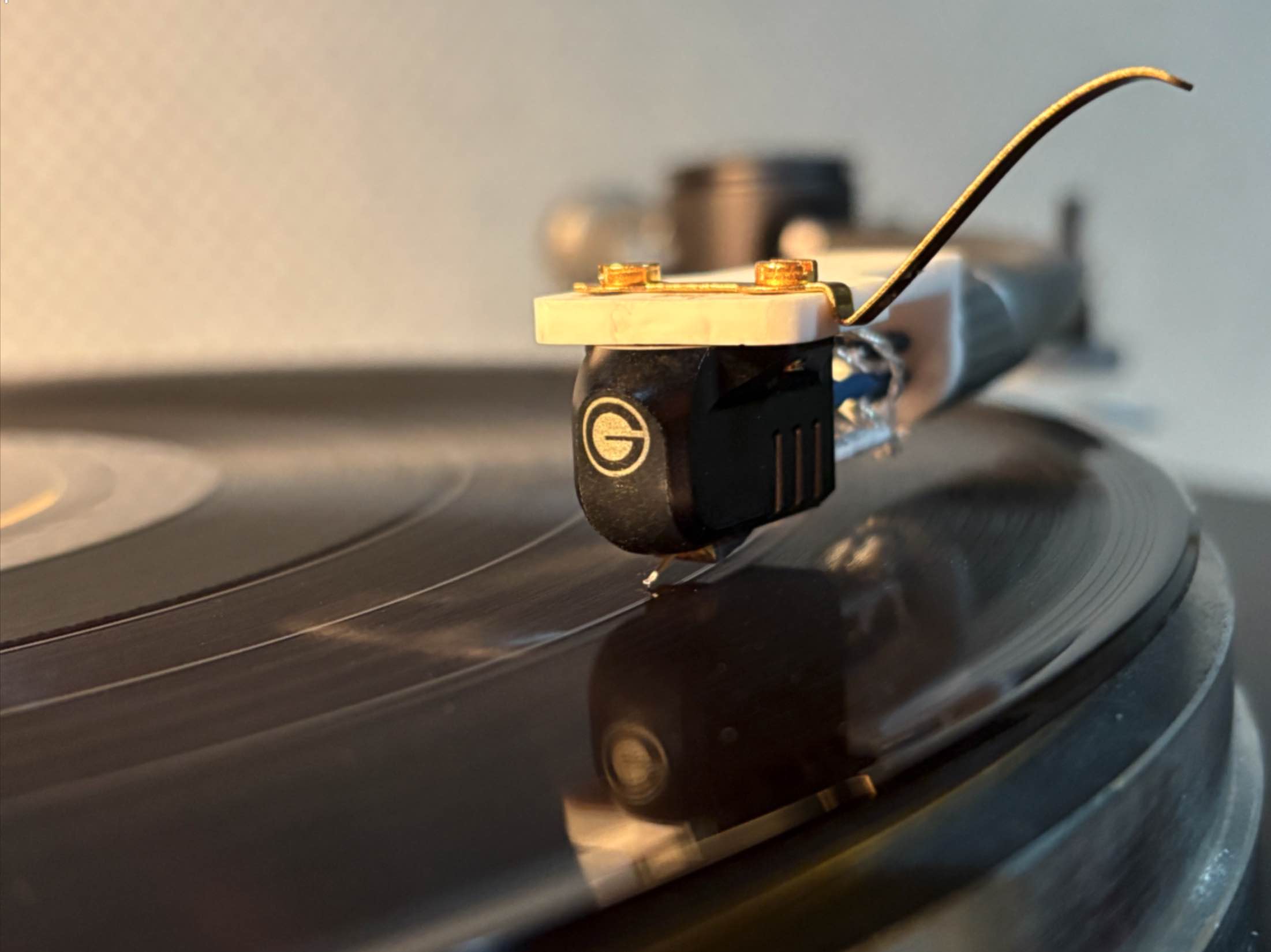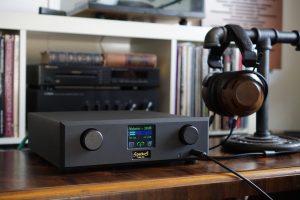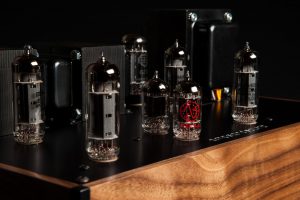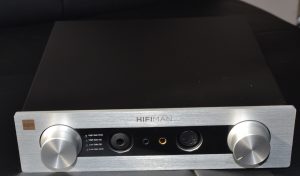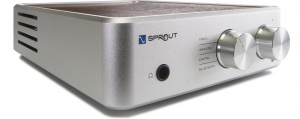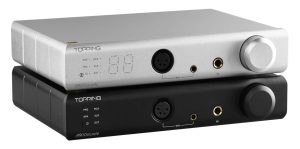If you enjoy headphone listening but prefer spending more of your cash on quality cans than amplification, the Soncoz SGA-1 headphone amplifier may be your new go-to device. Possessing XLR balanced and RCA outputs, teamed up with your favorite 'phones, a quality source and DAC, the Soncoz sets the stage for hours of pleasurable listening.
At 9.84" W x 2.17" H x 8.86" D and 4.41 lbs., the SGA-1 comes in an attractive black or gray metal case. Upfront, it features both a balanced XLR and a single ended quarter inch (6.35 mm) headphone jack to the left, an LCD display at center with gold font, and a knob to the right that governs gain, volume, and inputs selection by alternatively pressing, turning, clicking on your selection, and adjusting your levels with another turn. On its rear, it has, left to right, balanced XLR and RCA inputs, balanced XLR and RCA outputs, an IEC connector inlet, and an on/off switch.
The Soncoz SGA-1 also comes with its own gold plated 6.35mm male to 3.5mm female single ended headphone adapter jack that I put this to great use with, alternatively, a pair of Fostex T50RPmk3 headphones ($159.99, 101.99 dB sensitivity, 53.64 Ohm load) and the KLH Ultimate Open-Back Over Ear Headphones ($299.88, 97 dB sensitivity, 18Hz-22kHz frequency response) while awaiting the arrival of a pair of Dan Clark Audio Ether 2 Planar headphones ($2299, 92 dB sensitivity, 16 ohms load) equipped with an OEM balanced XLR cable sourced from Straight Wire.
Despite some qualms by some critics for employing a digital volume control because of potential signal degradation, I don't hear it. The Soncoz SGA-1 has a very low (i.e., non-existent to my ears) noise floor. Both the Fostex and KLH headphones yield pleasant, accurate, balanced, and robust presentations, but having enjoyed electrostatic speakers like the Quad 57, the Martin Logan Sequel and reQuests for their liquid and euphoric shimmery sound, I am very curious to hear how the SGA-1 drives the more expensive and luxuriant Ether 2 planar phones (planars, like electrostatics, employ a charged flat, thin film diaphragm instead of a voice coil ( trustedreviews.com)).
Specifications
- A precision digital audio input interface supports XLR balanced output and RCA output
- Linear power supply packaged with thick metal, equipped with an O-shaped transformer, and a linear regulator that can effectively isolate the multi-level power supply for the digital and analog parts
- Power input: AC110V
- Power consumption: <10W
- Amp output: Single Ended and Balanced
- Distortion plus noise @1kHz: <-117dB, <-118dB
- Freq @20Hz-20khz: ± 0.1dB, ± 0.1dB
- DNR @1kHz A-wt: <-124dB, <-126dB
- SNR @50mV A-wt: <-92dB, <-91cdB
- Crosstalk @10kHz: <-118dB, <-120dB
- Output voltage V=0, G=0: 4.0Vrms, 7.8Vrms
- Output impedance: 0.1Ω, 0.05Ω
- Noise: 1.88uVrms, 3.6uVrms
- Output Power V=0, G=0: 33Ω:420mW, 420mW 300Ω: 210mW, 840mW 600Ω:105mW,420mW
PRE Parameters
- Analog Inputs: XLR
- PRE outputs: RCA, XLR
- THD+N@1kHz: <-117dB, <-118dB
- Freq@20Hz-20khz: ±0.1dB, ±0.1dB
- DNR@1kHz A-wt: <-126dB, <-126dB
- SNR@50mV A-wt: <-95dB, <-94cdB
- Crosstalk@10kHz: <-132dB, <-136dB
- Output voltage V=0, G=0:2.0Vrms, 4.0Vrms
- Output impedance: 100Ω 200Ω
- Analog Inputs: RCA
A Few Technical Difficulties
With supply chain issues and back orders holding up delivery, it's several long months before the Ether 2 headphones arrive and, once they do, I run into a snag getting them to play. I check and re-check my input and output selections via the SGA-1's selector knob, yet I get no sound through the XLR cables they came with. Conversely, the KLH 'phones are playing just fine via unbalanced connection. I experience the same thing later at a friend's HiFi shop; playback via the unbalanced channel works fine, but a pair of his pricier headphones equipped with an XLR cable doesn't work.
Frustrated, I reach out to my contact for Soncoz, Yihua Chen, General Manager at Aoshida HIFI, who emails me a copy of illustrated directions on the input and output selection process.
Unsuccessful yet again at home, I double check my connections, I reconnect my Schiit Audio Yggdrasil OG DAC to the SGA-1 via Straight Wire Virtuoso R2 balanced XLR cables, plug and unplug the Ether 2's XLR cable upfront, and ensure that the selections are correct as per directions, No sound. I plug in the KLH 'phones via unbalanced connection, select the unbalanced icon for output and it plays fine. Still wearing the KLHs, I click over to the XLR icon for playback, hit "Play" on my iPhone's Roon Labs music player app and hear faint music. They are coming from the other headphones on my stand! Donning the Ether2 headphones, I realize that my efforts finally have finally paid off with a more luxuriant, intimate, and glistening soundstage.
I can't explain it.
However, now that the SGA-1 is driving the Ether 2 headphones, I have some serious listening to do.
An Ether-Real Experience
The issues ironed out, my frustration turns to elation, as with the Ether 2 headphones, the SGA-1 is stunning in its clarity and natural timbral delivery. Driven by the SGA-1, they conjure listening to Quad ESL 57 speakers linked to a pair of Duntech subwoofers or, alternatively, my former pair of Martin Logan reQuests driven by the powerful Mark Levinson ML-9 amp (which shouldn't surprise; as I suggested earlier, these speakers employ electrostatic transducers which sound more like the Ether 2's planar drivers than dynamic or standard moving coil ones commonly used). Capturing every nuance, they have a slightly warm, well defined, and full bodied bouquet. The resulting music is both immersive and sublime.
All that said, if a digital file's quality is subpar, the Soncoz doesn't do it any favors. While looking for songs to include in this review, I was disappointed with Bonnie Raitt's The Glow album that a friend had recommended. While it wasn't awful, it reminded me a bit of listening to lower res MP3 files playing from my son in law's cell phone plugged into my stereo. Similar to favorites like Franke and the Knockouts (No. 31) and, later, Hiram Bullock's Long Night Talk, some production shortfalls simply don't translate well on high fidelity digital playback. However, if it's a good recording, the Soncoz SGA-1 does a great job of spotlighting their strengths.
Here's a case in point: in Immanuel Wilkins' "Ferguson [An American Tradition]" (Immanuel Wilkins, Omega. Qobuz FLAC 96kHz 24-bit. Blue Note Records, August 7, 2020). Kweku Sumby's frenetic wooden stick taps on drum skins, then rims, are a palpable presence, spotlit against the dark, pensive backdrop of Micah Thomas's piano and Jason Moran's bass. When Wilkins' soprano sax sprites things up, the mix really shines. Wilkins' light, fleshy sax dances with shimmery cymbals, punchy drums, and counterpointing piano before cutting loose on a whaling sax solo reminiscent of Coltrane's phrasing and re-phrasing rants minutes later. Soon, Thomas' scorching piano lead kicks in, buttressed by crashing cymbals and a polyrhythmic drum kit.
Wilkins and Thomas are two magnificent sharks feasting in frenzied, serpentine swirls on a school of sardines—whose silver bodies flit and pulsate as one amidst the crimson gore in the azure Pacific—until, maws sated, the predators saunter off in the denouement. It's a living, breathing portal into a virtuosic performance replete with energy, raw textures and real space.
That sense of intimate proximity to the musicians continues with Cecile McLorin Salvant's "Devil May Care" (Cecile McLorin Salvant, Dreams and Daggers. Qobuz FLAC 96kHz, 24-bit. Mack Avenue Records, September 29, 2017). Aaron Diehl's buttery piano, the sound of shifting, the metallic din of the ride cymbal, the taut resonant double bass, and Salvant's luxuriant vocals are pristine, vivid and, after the drum solo subsides and the crowd cheers, you get a distinct sense of acoustics and scale at the Village Vanguard where it was recorded.
Then, the timbre of Steven Tyler's raspy vocals, effects and all, are belted out with authority and grit, while Joe Perry's electric guitar and bass, in tandem with Joey Kramer's snare and drum kit are rendered with plenty of punch and snap, presenting this very solid mix in "Big Ten Inch Record" with a fresh palpable air (Aerosmith, Toys in the Attic. DSD 64. Columbia, April 8, 1975).
Concluding Remarks
Over the last several months, the Soncoz SGA-1 Headphone Amplifier has proven to be a worthy companion piece to my dedicated two channel stereo system (you can see it by clicking on my byline).
Granted, there was the hiccup with playback over the XLR outputs, but that may have been an anomaly. That and the vulnerability of the paint finish (I scuffed it slightly after I set the Ether 2 headphones on top of it) were the only quibbles I had with the SGA-1.
Technical difficulties aside, however, I find the SGA-1 Headphone amplifier an attractive and delightful performer. With all three headphones I employed—and especially the Dan Clark Audio Ether 2 headphones—it delivered a rich, unfettered signal, allowing them to impart their signature sound with authority and aplomb. If you are looking for a relatively inexpensive, but high performance headphone amp, the Soncoz SGA-1 should be on your short list.
SGA-1 Soncoz Headphone Amplifier
Retail: $650
Aoshida HiFi




